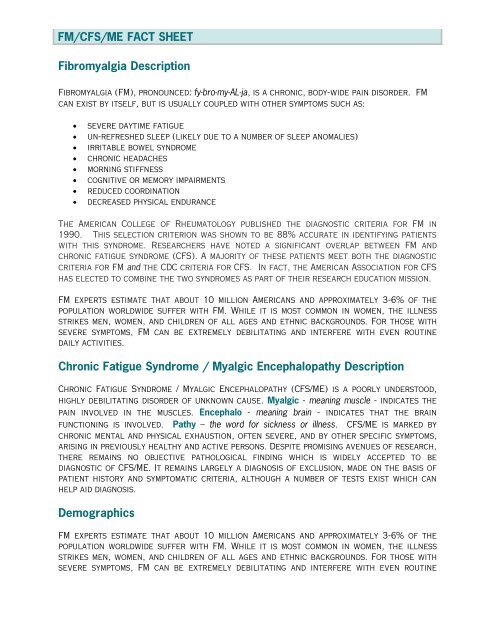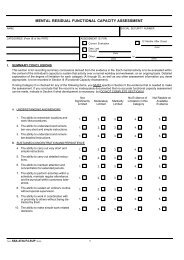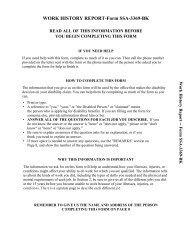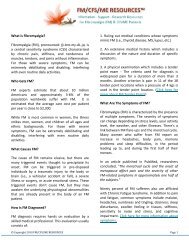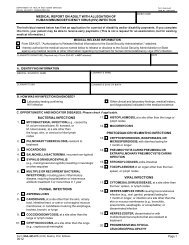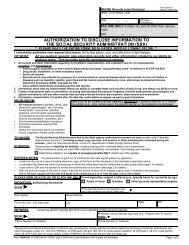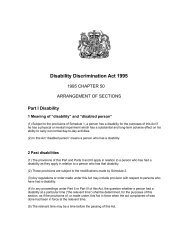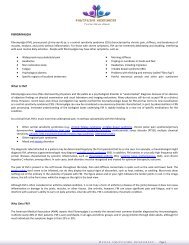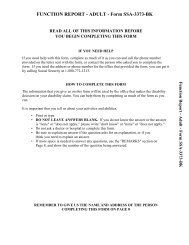Fibromyalgia Description.pdf - FM/CFS/ME Resources
Fibromyalgia Description.pdf - FM/CFS/ME Resources
Fibromyalgia Description.pdf - FM/CFS/ME Resources
Create successful ePaper yourself
Turn your PDF publications into a flip-book with our unique Google optimized e-Paper software.
<strong>FM</strong>/<strong>CFS</strong>/<strong>ME</strong> FACT SHEET<br />
<strong>Fibromyalgia</strong> <strong>Description</strong><br />
<strong>Fibromyalgia</strong> (<strong>FM</strong>), pronounced: fy-bro-my-AL-ja, is a chronic, body-wide pain disorder. <strong>FM</strong><br />
can exist by itself, but is usually coupled with other symptoms such as:<br />
• severe daytime fatigue<br />
• un-refreshed sleep (likely due to a number of sleep anomalies)<br />
• irritable bowel syndrome<br />
• chronic headaches<br />
• morning stiffness<br />
• cognitive or memory impairments<br />
• reduced coordination<br />
• decreased physical endurance<br />
The American College of Rheumatology published the diagnostic criteria for <strong>FM</strong> in<br />
1990. This selection criterion was shown to be 88% accurate in identifying patients<br />
with this syndrome. Researchers have noted a significant overlap between <strong>FM</strong> and<br />
chronic fatigue syndrome (<strong>CFS</strong>). A majority of these patients meet both the diagnostic<br />
criteria for <strong>FM</strong> and the CDC criteria for <strong>CFS</strong>. In fact, the American Association for <strong>CFS</strong><br />
has elected to combine the two syndromes as part of their research education mission.<br />
<strong>FM</strong> experts estimate that about 10 million Americans and approximately 3-6% of the<br />
population worldwide suffer with <strong>FM</strong>. While it is most common in women, the illness<br />
strikes men, women, and children of all ages and ethnic backgrounds. For those with<br />
severe symptoms, <strong>FM</strong> can be extremely debilitating and interfere with even routine<br />
daily activities.<br />
Chronic Fatigue Syndrome / Myalgic Encephalopathy <strong>Description</strong><br />
Chronic Fatigue Syndrome / Myalgic Encephalopathy (<strong>CFS</strong>/<strong>ME</strong>) is a poorly understood,<br />
highly debilitating disorder of unknown cause. Myalgic - meaning muscle - indicates the<br />
pain involved in the muscles. Encephalo - meaning brain - indicates that the brain<br />
functioning is involved. Pathy – the word for sickness or illness. <strong>CFS</strong>/<strong>ME</strong> is marked by<br />
chronic mental and physical exhaustion, often severe, and by other specific symptoms,<br />
arising in previously healthy and active persons. Despite promising avenues of research,<br />
there remains no objective pathological finding which is widely accepted to be<br />
diagnostic of <strong>CFS</strong>/<strong>ME</strong>. It remains largely a diagnosis of exclusion, made on the basis of<br />
patient history and symptomatic criteria, although a number of tests exist which can<br />
help aid diagnosis.<br />
Demographics<br />
<strong>FM</strong> experts estimate that about 10 million Americans and approximately 3-6% of the<br />
population worldwide suffer with <strong>FM</strong>. While it is most common in women, the illness<br />
strikes men, women, and children of all ages and ethnic backgrounds. For those with<br />
severe symptoms, <strong>FM</strong> can be extremely debilitating and interfere with even routine
<strong>FM</strong>/<strong>CFS</strong>/<strong>ME</strong> FACT SHEET<br />
daily activities. It is estimated that the average care cost per patient per year is close<br />
to $2,300.<br />
Chronic Fatigue Syndrome/Myalgic Encephalopathy (<strong>CFS</strong>/<strong>ME</strong>) is a highly debilitating<br />
disorder thought to affect approximately 4 per 1,000 adults in the United States and<br />
other countries, and a smaller fraction of children.<br />
Research studies indicate that the average <strong>FM</strong> and/or <strong>CFS</strong>/<strong>ME</strong> patient takes three<br />
different drugs daily in an attempt to control their symptoms, yet no single<br />
therapeutic agent was found to be effective in relieving the symptoms during the<br />
seven-year duration of the study (1989 to 1996).<br />
Disability Studies<br />
Four reports have shown that <strong>FM</strong> can be as disabling as rheumatoid arthritis (RA). RA is<br />
listed in the Social Security Disability law book, and while <strong>FM</strong> pain is acknowledged,<br />
the condition is not specifically listed. Due to the difficulties in gaining recognition<br />
for <strong>FM</strong> as a disabling illness, the percentage of patients drawing SSD payments based<br />
on <strong>FM</strong> is only 16.2%. Yet, nearly 30% of <strong>FM</strong> patients claim that they cannot hold down<br />
a steady job due to this condition. The total yearly drain on the U.S. economy is<br />
estimated to be over $20 billion. Preliminary findings indicate that the cancer risk is<br />
also doubled in people with <strong>FM</strong>.<br />
Patients with <strong>CFS</strong>/<strong>ME</strong> report critical reductions in levels of physical activity with<br />
impairment comparable to other fatiguing medical conditions including multiple<br />
sclerosis, late-stage AIDS, lupus, rheumatoid arthritis, heart disease, end-stage renal<br />
disease, chronic obstructive pulmonary disease (COPD), and the effects of<br />
chemotherapy. The severity of symptoms and disability is the same in both genders with<br />
strongly disabling chronic pain, but despite a common diagnosis, the functional capacity<br />
of individuals with <strong>CFS</strong>/<strong>ME</strong> varies greatly. While some lead relatively normal lives,<br />
others are totally bed-ridden and unable to care for themselves. Employment rates<br />
vary with over half unable to work and nearly two-thirds limited in their work because<br />
of their illness. More than half were on disability benefits or temporary sick leave,<br />
and less than a fifth worked full-time.<br />
Research Findings<br />
Pain is the predominant feature of <strong>FM</strong> and <strong>CFS</strong>/<strong>ME</strong>, but its cause is unknown. Significant<br />
abnormalities in the central and peripheral nervous systems have been uncovered in<br />
recent years and most researchers in the field consider <strong>FM</strong> and <strong>CFS</strong>/<strong>ME</strong> to be a central<br />
pain state (e.g., central sensitization). Substance P (SP) in the spinal fluid is three<br />
times that of normal healthy people. Nerve growth factor (NGF) in the spinal fluid is<br />
four times that of healthy people. Increased production of nitric oxide in the spinal<br />
fluid and in the peripheral blood of <strong>FM</strong> and <strong>CFS</strong>/<strong>ME</strong> patients has also been found. Proinflammatory<br />
cytokines are excessively produced in patients with <strong>FM</strong> and <strong>CFS</strong>/<strong>ME</strong>,<br />
pointing to an immune system Th1/Th2 axis disruption.<br />
The 2003 study by Ali Gur et al. demonstrated that the cytokine elevations correlated<br />
with abnormalities in brain blood flow based on SPECT scan analysis. Gur's 2002 study
<strong>FM</strong>/<strong>CFS</strong>/<strong>ME</strong> FACT SHEET<br />
showed that elevated IL-8 levels corresponded with pain intensity. It is proposed that<br />
pro-inflammatory cytokines produced by activated glial cells within the central<br />
nervous system may play an aetiopathogenetic role in <strong>FM</strong> and <strong>CFS</strong>/<strong>ME</strong>.<br />
Indeed, IL-8 has been implicated in a genetic profiling study using micro-arrays in<br />
patients meeting the <strong>CFS</strong>/<strong>ME</strong> criteria. Although the findings of elevated SP and NGF are<br />
substantial, recent research by the author of the NGF finding (Alice Larson, Ph.D.)<br />
clearly indicates that elevated SP and NGF are not at the heart of the etiology of <strong>FM</strong><br />
and <strong>CFS</strong>/<strong>ME</strong>. In fact, NK1 receptor antagonists are only likely to help <strong>FM</strong> and <strong>CFS</strong>/<strong>ME</strong><br />
patients when they are co-administered with an upload and noradrenaline (whose<br />
metabolite is abnormally low in the spinal fluid of <strong>FM</strong> and <strong>CFS</strong>/<strong>ME</strong> patients - and the<br />
same holds true for serotonin and dopamine).<br />
Other significant abnormalities in <strong>FM</strong> and <strong>CFS</strong>/<strong>ME</strong> patients include:<br />
• Sleep disorder.<br />
• Autonomic nervous system dysfunction.<br />
• Elevated activity of CRH neurons which is believed to cause disruption of many<br />
hormonal axes including the HPAaxis.<br />
• Impaired brain blood flow to the thalamus and other pain-processing centers.<br />
• Substantially reduced production of growth hormone overall, and additional<br />
blunting of growth hormone during exercise.<br />
• Failure of the diffuse noxious inhibitory control (DNIC or spatial summation) to<br />
respond to a painful stimulus.<br />
• Abnormal windup (or temporal summation) at rest and significantly exacerbated<br />
windup during exercise, which may explain the exercise intolerance that <strong>FM</strong><br />
patients exhibit.<br />
Current Status of Research Spending by NIH<br />
Most <strong>FM</strong> and <strong>CFS</strong>/<strong>ME</strong> research at NIH (National Institute of Health) is sponsored by<br />
NIAMS (National Institute of Arthritis, Musculoskeletal and Skin diseases). The 1997<br />
<strong>FM</strong> and <strong>CFS</strong>/<strong>ME</strong> research funding level at NIAMS measured out to only 0.6% of their<br />
annual budget of $257 million - not much for the second most common rheumatic<br />
disease.<br />
That same year, however, NIH created a Special Emphasis Panel (SEP) specifically for<br />
the review of <strong>FM</strong> and <strong>CFS</strong>/<strong>ME</strong> research grant applications, and this continues to lead to<br />
increased funding for the condition. In 1999, the National Institute of Neurological<br />
Diseases and Stroke (NINDS) and the Department of Defense (because of overlapping<br />
conditions such as Gulf War Illness) became involved in funding research on <strong>FM</strong> and<br />
<strong>CFS</strong>/<strong>ME</strong> as well.
<strong>FM</strong>/<strong>CFS</strong>/<strong>ME</strong> FACT SHEET<br />
While the increase in research funding on <strong>FM</strong> and <strong>CFS</strong>/<strong>ME</strong> is encouraging, the NIH<br />
funded research projects are, for the most part, still not focused on the patientrelevant<br />
issue of providing improved therapy options. A review of the NIH online<br />
Computer Retrieval of Information on Scientific Projects (CRISP) system abstracts<br />
confirms that less than 10% of government sponsored research on <strong>FM</strong> and <strong>CFS</strong>/<strong>ME</strong><br />
pertains to therapeutic interventions. However, the combined NIH and DOD<br />
expenditures on <strong>FM</strong> and <strong>CFS</strong>/<strong>ME</strong>-related research are estimated to be roughly $7<br />
million annually.<br />
Recent Therapeutic Success<br />
At the October 2002 American College of Rheumatology (ACR) meeting, several<br />
researchers presented successful treatment trials in <strong>FM</strong> and <strong>CFS</strong>/<strong>ME</strong> patients. In<br />
particular, a multi center pregabalin study demonstrated that <strong>FM</strong> and <strong>CFS</strong>/<strong>ME</strong> is a<br />
condition that can be evaluated and that clinical improvement is possible.<br />
Single bolus doses of fentanyl and dextromethorphan (tested individually) were<br />
documented to show clinical improvement and were also capable of substantially<br />
reducing windup in people with <strong>FM</strong> and <strong>CFS</strong>/<strong>ME</strong>. However, highly effective therapies that<br />
specifically target the central pain state in <strong>FM</strong> and <strong>CFS</strong>/<strong>ME</strong> patients are in high demand.<br />
Human growth hormone, a therapy that targets problems in the peripheral tissues, was<br />
shown in a nine month trial to be helpful in reducing muscular pain and relieving<br />
problems of exercise intolerance. A novel immune modulation Staphylococcal vaccinetype<br />
therapy to target the cytokines in the periphery has also shown effectiveness.<br />
Sodium Oxybate (a compounded version of the natural brain chemical gammahydroxybutyrate)<br />
has been tested in a placebo controlled crossover trial involving 17<br />
overnight sleep tests for each of the 20 <strong>FM</strong> and <strong>CFS</strong>/<strong>ME</strong> participants and showed<br />
amazing results. It produced significant increases in slow-wave sleep, decreased alphawave<br />
intrusion, decreased pain, and is suspected to also increase growth hormone<br />
secretion during sleep. The high prevalence, disability rate and health care costs<br />
associated with <strong>FM</strong> and <strong>CFS</strong>/<strong>ME</strong> should be motive enough to encourage the<br />
pharmaceutical industry to become involved in developing effective therapies for this<br />
condition.<br />
References<br />
• Wolfe F, Smythe HA, Yunus MB, Bennett RM, Bombardier C, Goldenberg DL, Tugwell P, Campbell SM, Abeles M,<br />
Clark P, et al.: The American College of Rheumatology 1990 Criteria for the Classification of <strong>Fibromyalgia</strong>. Report of<br />
the Multicenter Criteria Committee. Arthritis & Rheum 33(2):160-72, 1990.<br />
• Goldenberg DL, Simms RW, Geiger A, Komaroff AL: High frequency of <strong>FM</strong>S in patients with <strong>CFS</strong>. Arthritis & Rheum<br />
33(3):381-7, 1990.<br />
• Fukuda K, Straus SE, Hickie I, Sharpe MC, and Dobbins JG, Komaroff A: The chronic fatigue syndrome: A<br />
comprehensive approach to its definition and study. International Chronic Fatigue Syndrome Study Group. Ann Intern<br />
Med 121(12):953-9, 1994.<br />
• F, Ross K, Anderson J, Russell IJ, Hebert L: The prevalence and characteristics of fibromyalgia in the general population.<br />
Arthritis Rheum 38(1):19-28, 1995.<br />
• Gedalia A and Buskila D: Prevalence of <strong>FM</strong>S in children. J Rheumatology 20(2):368-70, 1993.
<strong>FM</strong>/<strong>CFS</strong>/<strong>ME</strong> FACT SHEET<br />
• Wolfe F, Anderson J, Harkness D, Bennett RM, Caro XJ, Goldenberg DL, Russell IJ, Yunus MB: A prospective,<br />
longitudinal multicenter study of service utilization and costs in fibromyalgia. Arthritis & Rheum 40(9):1560-70, 1997.<br />
• Silverman S and Mason J: Measuring the functional impact of <strong>FM</strong>S. J Musculosketal Med 9(7):15-24, 1992.<br />
• Wolfe F, et al.: Work and disability status of persons with <strong>FM</strong>S. J Rheumatology 24(6):1171-8, 1997.<br />
• Macfarlane GJ, et al.: Widespread body pain and mortality: Prospective population based study. BMJ 22:1-4, 2001.<br />
• Russell IJ, Orr MD, Littman B, Vipraio GA, Alboukrek D, Michalek JE, and Lopez Y, MacKillip F: Elevated cerebral<br />
spinal fluid levels of substance P in patients with <strong>FM</strong>S. Arthritis & Rheum 37(11):1593-601, 1994.<br />
• Giovengo SL, Russell IJ, and Larson AA: Increased concentration of nerve growth factor in cerebrospinal fluid of<br />
patients with fibromyalgia. J Rheumatology 26(7):1564-9, 1999.<br />
• Larson AA, Giovengo SL, Russell IJ, and Michalek JE: Changes in the concentrations of amino acids in the cerebrospinal<br />
fluid that correlate with pain in patients with fibromyalgia: Implications for nitric oxide pathways. Pain 87(2):201- 211,<br />
2000.<br />
• Bradley LA, Weigent DA, Sotolongo A, Alarcon GS, Arnold RE, Cianfrini LR, Kersh BC McKendree-Smith NL, Alberts<br />
KR, and Straight ES: Blood serum levels of nitric oxide (NO) are elevated in women with fibromyalgia (<strong>FM</strong>): Possible<br />
contributions to central and peripheral sensitization. Arthritis & Rheum 43(9 supply):S173 #638, 2000.<br />
• Wallace DJ, Linker-Israeli M, Hallegua D, Silverman S, Silver D, and Weisman MH: Cytokines play an<br />
aetiopathogenetic role in fibromyalgia: A hypothesis and pilot study. Rheumatology 40(7):743-749, 2001.<br />
• Salemi S, Rethage J, Wollina U, Michel BA, Gay RE, Gay S, Sprott H: Detection of interleukin 1$(IL-1$), IL-6, and<br />
tumor necrosis factor-” in skin of patients with fibromyalgia. J Rheumatology 30(1):146-50, 2003.<br />
• Gur A, Karakoc M, Erdogan S, Nas K, Cevik R, Sarac AJ: Regional cerebral blood flow and cytokines in young females<br />
with fibromyalgia. Clin Exp Rheumatology 20:753-760, 2003.<br />
• Gur A, Karakoc M, Nas K, Cevik R, Denli A, Sarac J: Cytokines and depression in cases with fibromyalgia. J<br />
Rheumatology 29(2):358-61, 2002.<br />
• Vernon SD, Unger ER, Dimulescu IM, Rajeevan M, Reeves WC: Utility of the blood for gene expression profiling and<br />
biomarker discovery in chronic fatigue syndrome. Disease Markers 18(4):193-199, 2002.<br />
• Velazquez RA, McCarson KE, Cai Y, Kovacs KJ, Shi Q, Evensjo M, Larson AA: Upregulation of neurokinin-1 receptor<br />
expression in rat spinal cord by an N-terminal metabolite of substance P. Eur J of Neuroscience, 16(2):229- 241, 2002<br />
• Jasmin L, Tien D, Weinshenker D, Palmiter RD, Green PG, Janni G, and Ohara PT: The NK1 receptor mediates both the<br />
hyperalgesia and the resistance to morphine in mice lacking noradrenaline. PNAS 99(2):1029-1034, 2002.<br />
• Russell IJ, Vaeroy H, Javors M, Nyberg F: Cerebrospinal fluid biogenic amine metabolites in fibromyalgia/fibrositis<br />
syndrome and rheumatoid arthritis. Arthritis & Rheum 35(5):550-6, 1992.<br />
• Roizenblatt S, Moldofsky H, and Benedito-Silva AA, Tufik S: “Alpha sleep characteristics in fibromyalgia. Arthritis &<br />
Rheum 44(1): 222-230, 2001.<br />
• Martinez-Lavin M, Hermosillo AG, Rosas M, Soto <strong>ME</strong>: Circadian studies of autonomic nervous balance in patients with<br />
fibromyalgia. A heart rate variability analysis. Arthritis & Rheum 41(11):1966-1971, 1998.<br />
• Riedel W, Schlapp U, Leck S, Netter P, Neeck G: Blunted ACTH and cortisol responses to systemic injection of<br />
corticotropin-releasing hormone (CRH) in fibromyalgia: role of somatostatin and CRH-binding protein. Ann NY Acad<br />
Sci 966:483-490, 2002.<br />
• Neeck G and Crofford LJ: Neuroendocrine perturbations in fibromyalgia and chronic fatigue syndrome. Rheumatic<br />
Disease Clinics of North America 26(4): 989-1002, 2000.<br />
• Kwiatek R, Barnden L, Tedman R, Jarrett R, Chew J, Rowe C, Pile K: Regional cerebral blood flow in fibromyalgia.<br />
Arthritis & Rheum 43(12):2823-2833, 2000.<br />
• Mountz JM, Bradley LA, Modell JG, Alexander RW, Triana-Alexander M, Aaron LA, Stewart KE, Alarcon GS, and<br />
Mountz JD: <strong>Fibromyalgia</strong> in women–Abnormalities of regional cerebral blood flow in the thalamus and the caudate<br />
nucleus are associated with low pain threshold levels. Arthritis & Rheum 38(7):926-938, 1995.<br />
• Gracely RH, Petzke F, Wolf JM, Clauw DJ: Functional magnetic resonance imaging evidence of augmented pain<br />
processing in fibromyalgia. Arthritis & Rheum 46(5):1333-1343, 2002.<br />
• Bennett RM, Cook DM, Clark SR, Burckhardt CS, Campbell SM: Hypothalamic-pituitary-insulin-like growth factor-I<br />
axis dysfunction in patients with fibromyalgia. J Rheum 24(7):1384-9, 1997.<br />
• Paiva ES, Deodhar A, and Jones KD, Bennett R: Impaired growth hormone secretion in fibromyalgia patients. Arthritis &<br />
Rheum 46(5):1344-1350, 2002.<br />
• Staud R, Vierck CJ, Cannon RL, Mauderli AP, Price DD: Abnormal sensitization and temporal summation of second pain<br />
(wind-up) in patients with fibromyalgia syndrome. Pain 91(1-2):165-175, 2001.<br />
• Vierck CJ, Staud R, Price DD, Cannon RL, Mauderli AP, Martin AD: The effect of maximal exercise on temporal<br />
summation of second pain (wind-up) in patients with fibromyalgia syndrome. J of Pain 2(6):334-344, 2001.
<strong>FM</strong>/<strong>CFS</strong>/<strong>ME</strong> FACT SHEET<br />
• Julien N, Arsenault P, Marchand S: Deficit of endogenous pain inhibitory systems found in fibromyalgia patients but not<br />
in those with low-back pain. IASP San Diego, August 2002 (study being prepared for publication).<br />
• Staud R, Robinson <strong>ME</strong>, Vierck CJ, and Price DD: Diffuse noxious inhibitory controls (DNIC) attenuate temporal<br />
summation of second pain in normal males but not in normal females or fibromyalgia patients. Pain 101:167-174, 2003.<br />
• 105th Congress SENATE APPROPRIATIONS REPORT - Sept. 1996.<br />
• CRISP - Computer Retrieval of Information on Scientific Projects at http://crisp.cit.nih.gov<br />
• Crofford L, et al.: Pregabalin improves pain associated with fibromyalgia syndrome in a multicenter, randomized,<br />
placebo-controlled monotherapy trial. Arthritis & Rheum 46(9 suppl):S613 #1653, 2002.<br />
• Staud R, Robinson <strong>ME</strong>, Mauderli AP, Cannon RL, Vierck CJ, and Price DD: Opioids modulate the enhanced temporal<br />
summation of second pain of fibromyalgia patients. Arthritis & Rheum 46(9 suppl):S396#1027, 2002. Dr. Staud also<br />
presented his data on dextromethorphan at this ACR meeting, Oct. 2002.<br />
• Bennett RM, Clark SC, Walczyk K et al.: A randomized, double-blind, placebo-controlled study of growth hormone in<br />
the treatment of fibromyalgia. American Journal of Medicine 104:227-231, 1998.<br />
• Zachrisson O, Regland B, Jahreskog M, Jonsson M, Kron M, Gottfries CG: Treatment with staphylococcus toxoid in<br />
fibromyalgia/chronic fatigue syndrome–a randomized controlled trial. Eur J Pain 6(6):455-466, 2002.<br />
• Scharf MB, Baumann M, Berkowitz DV: The effects of sodium Oxybate on clinical symptoms and sleep patterns in<br />
patients with fibromyalgia. J Rheumatology 30(5):1070-7, 2003.<br />
Copyright © 2009 <strong>FM</strong>/<strong>CFS</strong>/<strong>ME</strong> RESOURCES - http://fmcfsme.d-3systems.com/<br />
Prepared: February 22, 2009


